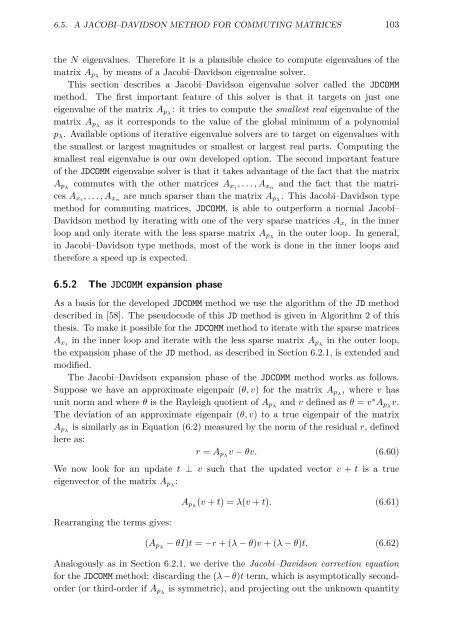link to my thesis
link to my thesis
link to my thesis
Create successful ePaper yourself
Turn your PDF publications into a flip-book with our unique Google optimized e-Paper software.
6.5. A JACOBI–DAVIDSON METHOD FOR COMMUTING MATRICES 103<br />
the N eigenvalues. Therefore it is a plausible choice <strong>to</strong> compute eigenvalues of the<br />
matrix A pλ by means of a Jacobi–Davidson eigenvalue solver.<br />
This section describes a Jacobi–Davidson eigenvalue solver called the JDCOMM<br />
method. The first important feature of this solver is that it targets on just one<br />
eigenvalue of the matrix A pλ : it tries <strong>to</strong> compute the smallest real eigenvalue of the<br />
matrix A pλ as it corresponds <strong>to</strong> the value of the global minimum of a polynomial<br />
p λ . Available options of iterative eigenvalue solvers are <strong>to</strong> target on eigenvalues with<br />
the smallest or largest magnitudes or smallest or largest real parts. Computing the<br />
smallest real eigenvalue is our own developed option. The second important feature<br />
of the JDCOMM eigenvalue solver is that it takes advantage of the fact that the matrix<br />
A pλ commutes with the other matrices A xi ,...,A xn and the fact that the matrices<br />
A xi ,...,A xn are much sparser than the matrix A pλ . This Jacobi–Davidson type<br />
method for commuting matrices, JDCOMM, is able <strong>to</strong> outperform a normal Jacobi–<br />
Davidson method by iterating with one of the very sparse matrices A xi in the inner<br />
loop and only iterate with the less sparse matrix A pλ in the outer loop. In general,<br />
in Jacobi–Davidson type methods, most of the work is done in the inner loops and<br />
therefore a speed up is expected.<br />
6.5.2 The JDCOMM expansion phase<br />
As a basis for the developed JDCOMM method we use the algorithm of the JD method<br />
described in [58]. The pseudocode of this JD method is given in Algorithm 2 of this<br />
<strong>thesis</strong>. To make it possible for the JDCOMM method <strong>to</strong> iterate with the sparse matrices<br />
A xi in the inner loop and iterate with the less sparse matrix A pλ in the outer loop,<br />
the expansion phase of the JD method, as described in Section 6.2.1, is extended and<br />
modified.<br />
The Jacobi–Davidson expansion phase of the JDCOMM method works as follows.<br />
Suppose we have an approximate eigenpair (θ, v) for the matrix A pλ , where v has<br />
unit norm and where θ is the Rayleigh quotient of A pλ and v defined as θ = v ∗ A pλ v.<br />
The deviation of an approximate eigenpair (θ, v) <strong>to</strong> a true eigenpair of the matrix<br />
A pλ is similarly as in Equation (6.2) measured by the norm of the residual r, defined<br />
here as:<br />
r = A pλ v − θv. (6.60)<br />
We now look for an update t ⊥ v such that the updated vec<strong>to</strong>r v + t is a true<br />
eigenvec<strong>to</strong>r of the matrix A pλ :<br />
Rearranging the terms gives:<br />
A pλ (v + t) =λ(v + t). (6.61)<br />
(A pλ − θI)t = −r +(λ − θ)v +(λ − θ)t. (6.62)<br />
Analogously as in Section 6.2.1, we derive the Jacobi–Davidson correction equation<br />
for the JDCOMM method: discarding the (λ − θ)t term, which is asymp<strong>to</strong>tically secondorder<br />
(or third-order if A pλ is symmetric), and projecting out the unknown quantity

















